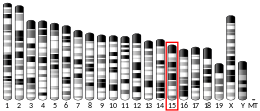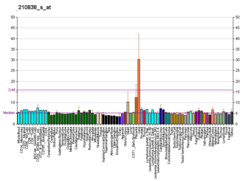ACVRL1
Serine/threonine-protein kinase receptor R3 is an enzyme that in humans is encoded by the ACVRL1 gene.[5][6][7]
ACVRL1 is a receptor in the TGF beta signaling pathway. It is also known as activin receptor-like kinase 1, or ALK1.
Function
This gene encodes a type I cell-surface receptor for the TGF-beta superfamily of ligands. It shares with other type I receptors a high degree of similarity in serine-threonine kinase subdomains, a glycine- and serine-rich region (called the GS domain) preceding the kinase domain, and a short C-terminal tail. The encoded protein, sometimes termed ALK1, shares similar domain structures with other closely related ALK or activin receptor-like kinase proteins that form a subfamily of receptor serine/threonine kinases. Mutations in this gene are associated with hemorrhagic telangiectasia type 2, also known as Rendu-Osler-Weber syndrome 2.[7]
Pathology
Germline mutations of ACVRL1 are associated with:
- hereditary hemorrhagic telangiectasia type 2 (Rendu-Osler-Weber syndrome 2)[8]
- Pulmonary arteriovenous malformations[9]
Somatic mosaicism in ACVRL1 are associated with severe pulmonary arterial hypertension.[10]
ACVRL1 directly interacts with low-density lipoprotein (LDL), which implies that it might initiate the early phases of atherosclerosis.[11]
As a drug target
- Dalantercept is an experimental ALK1 inhibitor.[12]
Closely/family related kinases
(Not to be confused with anaplastic lymphoma kinase (ALK) )
ALK4 is ACVR1B, ALK7 is ACVR1C, and ALK5 is [part of] the TGF-β type I receptor.[13]
See also
- TGF beta signaling pathway, see summary table for ALK*
References
- GRCh38: Ensembl release 89: ENSG00000139567 - Ensembl, May 2017
- GRCm38: Ensembl release 89: ENSMUSG00000000530 - Ensembl, May 2017
- "Human PubMed Reference:". National Center for Biotechnology Information, U.S. National Library of Medicine.
- "Mouse PubMed Reference:". National Center for Biotechnology Information, U.S. National Library of Medicine.
- ten Dijke P, Ichijo H, Franzén P, Schulz P, Saras J, Toyoshima H, Heldin CH, Miyazono K (October 1993). "Activin receptor-like kinases: a novel subclass of cell-surface receptors with predicted serine/threonine kinase activity". Oncogene. 8 (10): 2879–87. PMID 8397373.
- Johnson DW, Berg JN, Baldwin MA, Gallione CJ, Marondel I, Yoon SJ, Stenzel TT, Speer M, Pericak-Vance MA, Diamond A, Guttmacher AE, Jackson CE, Attisano L, Kucherlapati R, Porteous ME, Marchuk DA (June 1996). "Mutations in the activin receptor-like kinase 1 gene in hereditary haemorrhagic telangiectasia type 2". Nature Genetics. 13 (2): 189–95. doi:10.1038/ng0696-189. PMID 8640225.
- "Entrez Gene: ACVRL1 activin A receptor type II-like 1".
- Olivieri C, Mira E, Delù G, Pagella F, Zambelli A, Malvezzi L, Buscarini E, Danesino C (July 2002). "Identification of 13 new mutations in the ACVRL1 gene in a group of 52 unselected Italian patients affected by hereditary haemorrhagic telangiectasia". Journal of Medical Genetics. 39 (7): 39e–39. doi:10.1136/jmg.39.7.e39. PMC 1735165. PMID 12114496.
- Vandenbriele C, Peerlinck K, de Ravel T, Verhamme P, Vanassche T (April 2014). "Pulmonary arterio-venous malformations in a patient with a novel mutation in exon 10 of the ACVRL1 gene". Acta Clinica Belgica. 69 (2): 139–41. doi:10.1179/0001551213Z.00000000012. PMID 24724759.
- Jones G, Robertson L, Harrison R, Ridout C, Vasudevan P (August 2014). "Somatic mosaicism in ACVRL1 with transmission to several offspring affected with severe pulmonary arterial hypertension". American Journal of Medical Genetics. Part A. 164A (8): 2121–3. doi:10.1002/ajmg.a.36568. PMID 24753439.
- Kraehling JR, Chidlow JH, Rajagopal C, Sugiyama MG, Fowler JW, Lee MY, Zhang X, Ramírez CM, Park EJ, Tao B, Chen K, Kuruvilla L, Larriveé B, Folta-Stogniew E, Ola R, Rotllan N, Zhou W, Nagle MW, Herz J, Williams KJ, Eichmann A, Lee WL, Fernández-Hernando C, Sessa WC (November 2016). "Genome-wide RNAi screen reveals ALK1 mediates LDL uptake and transcytosis in endothelial cells". Nature Communications. 7: 13516. Bibcode:2016NatCo...713516K. doi:10.1038/ncomms13516. PMC 5121336. PMID 27869117.
- Gupta S, Gill D, Pal SK, Agarwal N (2015). "Activin receptor inhibitors--dalantercept". Current Oncology Reports. 17 (4): 14. doi:10.1007/s11912-015-0441-5. PMID 25708802.
- Laping NJ, Grygielko E, Mathur A, Butter S, Bomberger J, Tweed C, Martin W, Fornwald J, Lehr R, Harling J, Gaster L, Callahan JF, Olson BA (July 2002). "Inhibition of transforming growth factor (TGF)-beta1-induced extracellular matrix with a novel inhibitor of the TGF-beta type I receptor kinase activity: SB-431542". Molecular Pharmacology. 62 (1): 58–64. doi:10.1124/mol.62.1.58. PMID 12065755.
Further reading
- Attisano L, Cárcamo J, Ventura F, Weis FM, Massagué J, Wrana JL (November 1993). "Identification of human activin and TGF beta type I receptors that form heteromeric kinase complexes with type II receptors". Cell. 75 (4): 671–80. doi:10.1016/0092-8674(93)90488-C. PMID 8242742.
- Johnson DW, Berg JN, Gallione CJ, McAllister KA, Warner JP, Helmbold EA, Markel DS, Jackson CE, Porteous ME, Marchuk DA (August 1995). "A second locus for hereditary hemorrhagic telangiectasia maps to chromosome 12". Genome Research. 5 (1): 21–8. doi:10.1101/gr.5.1.21. PMID 8717052.
- Panchenko MP, Williams MC, Brody JS, Yu Q (April 1996). "Type I receptor serine-threonine kinase preferentially expressed in pulmonary blood vessels". The American Journal of Physiology. 270 (4 Pt 1): L547-58. doi:10.1152/ajplung.1996.270.4.L547. PMID 8928814.
- Berg JN, Gallione CJ, Stenzel TT, Johnson DW, Allen WP, Schwartz CE, Jackson CE, Porteous ME, Marchuk DA (July 1997). "The activin receptor-like kinase 1 gene: genomic structure and mutations in hereditary hemorrhagic telangiectasia type 2". American Journal of Human Genetics. 61 (1): 60–7. doi:10.1086/513903. PMC 1715857. PMID 9245985.
- Stockwell BR, Schreiber SL (June 1998). "Probing the role of homomeric and heteromeric receptor interactions in TGF-beta signaling using small molecule dimerizers". Current Biology. 8 (13): 761–70. doi:10.1016/S0960-9822(98)70299-4. PMID 9651680.
- Lux A, Attisano L, Marchuk DA (April 1999). "Assignment of transforming growth factor beta1 and beta3 and a third new ligand to the type I receptor ALK-1". The Journal of Biological Chemistry. 274 (15): 9984–92. doi:10.1074/jbc.274.15.9984. PMID 10187774.
- Klaus DJ, Gallione CJ, Anthony K, Yeh EY, Yu J, Lux A, Johnson DW, Marchuk DA (2000). "Novel missense and frameshift mutations in the activin receptor-like kinase-1 gene in hereditary hemorrhagic telangiectasia. Mutations in brief no. 164. Online". Human Mutation. 12 (2): 137–138. doi:10.1002/(SICI)1098-1004(1998)12:2<137::AID-HUMU16>3.0.CO;2-J. PMID 10694922.
- Oh SP, Seki T, Goss KA, Imamura T, Yi Y, Donahoe PK, Li L, Miyazono K, ten Dijke P, Kim S, Li E (March 2000). "Activin receptor-like kinase 1 modulates transforming growth factor-beta 1 signaling in the regulation of angiogenesis". Proceedings of the National Academy of Sciences of the United States of America. 97 (6): 2626–31. Bibcode:2000PNAS...97.2626O. doi:10.1073/pnas.97.6.2626. PMC 15979. PMID 10716993.
- Abdalla SA, Pece-Barbara N, Vera S, Tapia E, Paez E, Bernabeu C, Letarte M (May 2000). "Analysis of ALK-1 and endoglin in newborns from families with hereditary hemorrhagic telangiectasia type 2". Human Molecular Genetics. 9 (8): 1227–37. doi:10.1093/hmg/9.8.1227. PMID 10767348.
- Kjeldsen AD, Brusgaard K, Poulsen L, Kruse T, Rasmussen K, Green A, Vase P (February 2001). "Mutations in the ALK-1 gene and the phenotype of hereditary hemorrhagic telangiectasia in two large Danish families". American Journal of Medical Genetics. 98 (4): 298–302. doi:10.1002/1096-8628(20010201)98:4<298::AID-AJMG1093>3.0.CO;2-K. PMID 11170071.
- Wurthner JU, Frank DB, Felici A, Green HM, Cao Z, Schneider MD, McNally JG, Lechleider RJ, Roberts AB (June 2001). "Transforming growth factor-beta receptor-associated protein 1 is a Smad4 chaperone". The Journal of Biological Chemistry. 276 (22): 19495–502. doi:10.1074/jbc.M006473200. PMID 11278302.
- Parks WT, Frank DB, Huff C, Renfrew Haft C, Martin J, Meng X, de Caestecker MP, McNally JG, Reddi A, Taylor SI, Roberts AB, Wang T, Lechleider RJ (June 2001). "Sorting nexin 6, a novel SNX, interacts with the transforming growth factor-beta family of receptor serine-threonine kinases". The Journal of Biological Chemistry. 276 (22): 19332–9. doi:10.1074/jbc.M100606200. PMID 11279102.
- Birkey Reffey S, Wurthner JU, Parks WT, Roberts AB, Duckett CS (July 2001). "X-linked inhibitor of apoptosis protein functions as a cofactor in transforming growth factor-beta signaling". The Journal of Biological Chemistry. 276 (28): 26542–9. doi:10.1074/jbc.M100331200. PMID 11356828.
- Trembath RC, Thomson JR, Machado RD, Morgan NV, Atkinson C, Winship I, Simonneau G, Galie N, Loyd JE, Humbert M, Nichols WC, Morrell NW, Berg J, Manes A, McGaughran J, Pauciulo M, Wheeler L (August 2001). "Clinical and molecular genetic features of pulmonary hypertension in patients with hereditary hemorrhagic telangiectasia" (PDF). The New England Journal of Medicine. 345 (5): 325–34. doi:10.1056/NEJM200108023450503. PMID 11484689.
- Inman GJ, Nicolás FJ, Callahan JF, Harling JD, Gaster LM, Reith AD, Laping NJ, Hill CS (July 2002). "SB-431542 is a potent and specific inhibitor of transforming growth factor-beta superfamily type I activin receptor-like kinase (ALK) receptors ALK4, ALK5, and ALK7". Molecular Pharmacology. 62 (1): 65–74. doi:10.1124/mol.62.1.65. PMID 12065756.
- Olivieri C, Mira E, Delù G, Pagella F, Zambelli A, Malvezzi L, Buscarini E, Danesino C (July 2002). "Identification of 13 new mutations in the ACVRL1 gene in a group of 52 unselected Italian patients affected by hereditary haemorrhagic telangiectasia". Journal of Medical Genetics. 39 (7): 39e–39. doi:10.1136/jmg.39.7.e39. PMC 1735165. PMID 12114496.
- Mo J, Fang SJ, Chen W, Blobe GC (December 2002). "Regulation of ALK-1 signaling by the nuclear receptor LXRbeta". The Journal of Biological Chemistry. 277 (52): 50788–94. doi:10.1074/jbc.M210376200. PMID 12393874.
- Lamouille S, Mallet C, Feige JJ, Bailly S (December 2002). "Activin receptor-like kinase 1 is implicated in the maturation phase of angiogenesis". Blood. 100 (13): 4495–501. doi:10.1182/blood.V100.13.4495. PMID 12453878.
- Mitchell D, Pobre EG, Mulivor AW, Grinberg AV, Castonguay R, Monnell TE, Solban N, Ucran JA, Pearsall RS, Underwood KW, Seehra J, Kumar R (February 2010). "ALK1-Fc inhibits multiple mediators of angiogenesis and suppresses tumor growth". Molecular Cancer Therapeutics. 9 (2): 379–88. doi:10.1158/1535-7163.MCT-09-0650. PMID 20124460.
External links
- GeneReviews/NCBI/NIH/UW entry on Hereditary Hemorrhagic Telangiectasia
- Human ACVRL1 genome location and ACVRL1 gene details page in the UCSC Genome Browser.
This article incorporates text from the United States National Library of Medicine, which is in the public domain.




